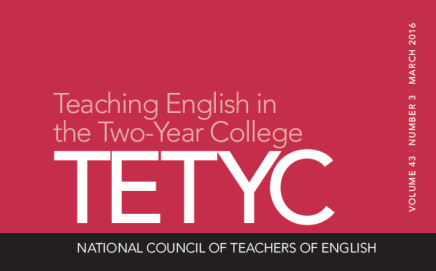Teaching English in the Two Year College invites proposals for a September 2020 themed special issue on Dual Credit and Concurrent Enrollment:
As the National Alliance of Concurrent Enrollment Partnerships, the national organization that has set standards around concurrent enrollment and offers program accreditation documents, in 2010, 1.4 million students took a dual credit course (earning college credit as high school students), and these numbers are only increasing. Policymakers in many states (including in Texas, Oregon, Iowa, Colorado, and others) have set goals or passed legislation to ensure high school students have access to or even complete specific minimum numbers of college credits prior to starting college. Some research suggests that dual credit coursework has a positive impact on college success and the college going choices of first-generation and low-income students.
National organizations in English Studies have issued statements on best practices and guidelines for dual credit including the “CCCC Statement on Dual Credit/Concurrent Enrollment Composition: Policy and Best Practices,” the “CWPA Position Statement on Pre-College Credit for Writing” and the “TYCA Executive Committee Statement on Concurrent Enrollment.” A joint organizational statement on dual credit/concurrent enrollment is also in progress to be issued collaboratively by multiple writing studies national groups, and the 2012 NCTE volume College Credit for Writing in High School: The “Taking Care of” Business has also offered a scholarly foundation for concurrent enrollment work in English studies.
I invite 500-word special issue submission proposals that address dual credit/concurrent enrollment issues especially those that focus on how these issues play out at community colleges.
Some possible topics might include:
- Best practices for dual credit partnerships
- Pedagogical considerations and recommendations
- Administration of dual credit programs
- Curriculum development
- Student readiness
- Professional development, mentoring, and ongoing support
- Models for delivering dual credit/concurrent enrollment (online, hybrid, in high schools, on college campuses)
- Classroom practices
- Program assessment
- Challenges and opportunities
- The student experience
- Longitudinal studies
Timeline
- Submit 500 word proposals by April 1, 2019 to the TETYC Editorial Manager submission system. Proposals should identify the major questions and/or arguments that will be addressed, provide a scholarly context, and describe the methodologies that will be used. TETYC uses MLA documentation, 8th edition.
- Complete manuscripts will be invited by June 1, 2019 after proposals are reviewed by the journal’s editorial board or additional invited peer reviewers.
- Complete manuscripts will be due to the editor by December 30, 2019
- Publication will be in the September 2020 issue
TETYC is a peer-reviewed journal published by the National Council of Teachers of English. Questions can be directed to editor, Holly Hassel, at tetyc.editor@gmail.com. General submission guidelines and instructions can be found here.
